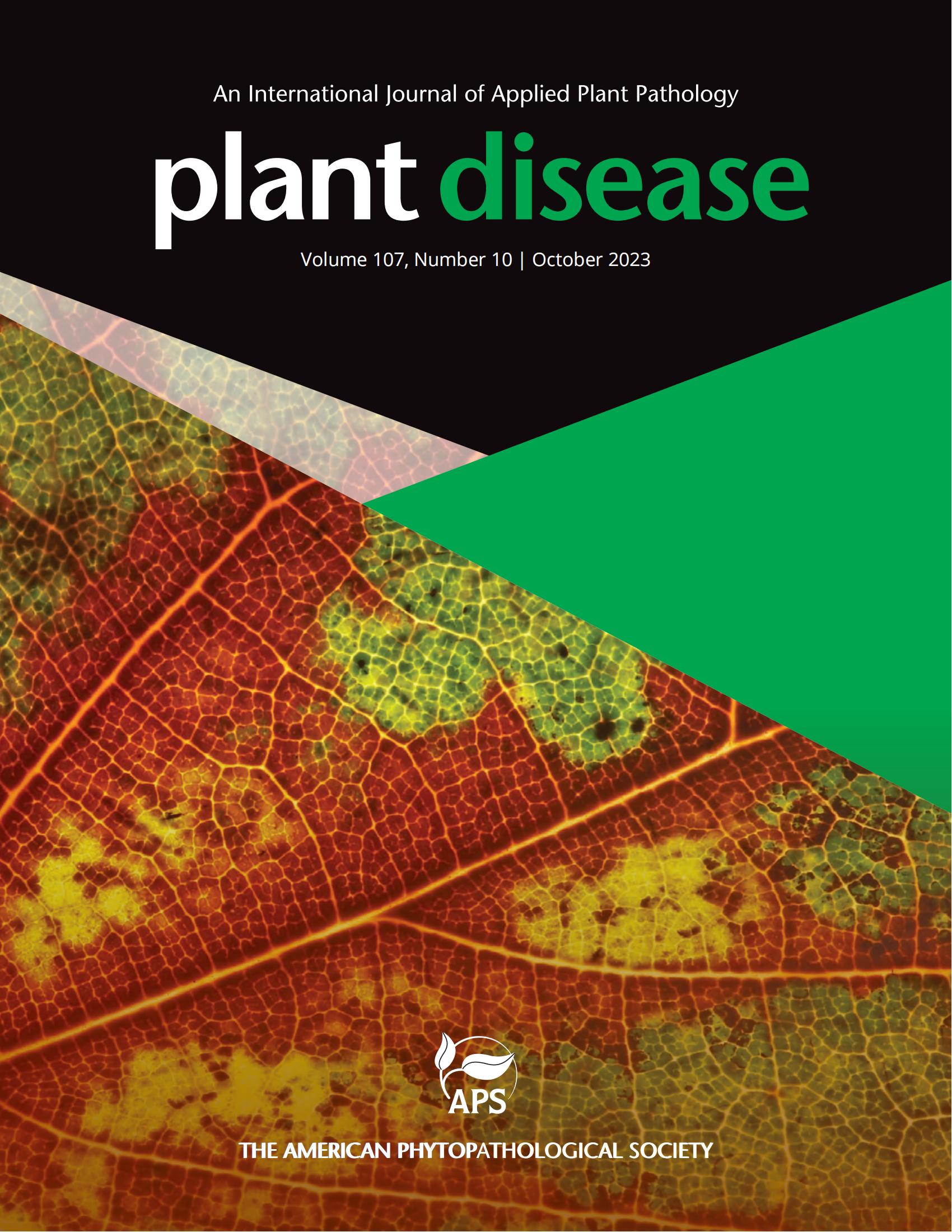美国爱达荷州甜菜中首次发现虹膜黄斑病毒和菠菜卷顶病毒。
摘要
甜菜(Beta vulgaris L.),种植在世界各地的糖生产,是易受各种病毒性疾病。由于混合感染可能导致疾病症状,因此确定因果病毒病原体可能很困难。在2022年秋季,在爱达荷州帕尔马东南部约40英亩的商业地里,观察到甜菜植物普遍泛黄、褪绿、静脉清除和卷曲叶症状,疾病发病率为10%至15%。叶子症状类似于病毒黄化,这是一种已知的甜菜病,由多种病毒、甜菜黄化病毒、甜菜西部黄化病毒和甜菜萎黄病毒引起(Wintermantel, 2005)。为了确定导致症状的病原病毒,使用RNeasy Plant Mini Kit (Qiagen, CA)从四种植物的有症状叶片中分离出总RNA。在耗尽核糖体RNA后,构建测序文库并使用具有150 bp对端平台的Illumina NovaSeq 6000进行高通量测序(HTS) (Novogene, CA)。经过适配器修剪,共获得7167万条高质量reads (Q>30)。在移除与宿主基因组相关的reads后,使用SPAdes组装器将剩余的1424万个reads组装成contigs (Bankevich et al. 2012;Prjibelski et al. 2020)。将得到的101513个contigs与NCBI非冗余数据库进行比对,以识别与已知病毒匹配的contigs。组装得到鸢尾黄斑病毒(irdimaculaflai, IYSV) L、M、S三个片段的全基因组,与对应的参考序列NC_029799、FJ361359和OR526471的同源性分别为98.08%、98.98%和96.65%,覆盖率为99 ~ 100%。在美国爱达荷州发现的IYSV的L (8863 nt)、M (4823 nt)和S (3121 nt)片段的全长序列,分别以PQ246270、PQ246271和PQ246272收录于GenBank中。此外,在甜菜中鉴定出的一个2860 nt序列与PQ246273一起储存在GenBank中,该序列对菠菜卷顶病毒(菠菜卷顶亚利桑那病毒,SpCTAV) HQ443515具有98.57%的识别性和100%的覆盖率。SpCTAV最初在亚利桑那州的菠菜中被发现(Hernandez-Zepeda et al. 2013),最近在爱达荷州种植的红表甜菜(Ramachandran et al. 2023)和爱达荷州的甜菜叶虫(cirlifer tenellus)中被发现(Strausbaugh et al. 2024)。因此,目前的研究在爱达荷州的甜菜中发现了SpCTAV。在2024年收集的额外甜菜样本中,进一步检查了爱达荷州东南部帕尔马地区的IYSV发病率。从15株单株的叶片中提取总RNA, RT-PCR得到IYSV的L、M和S片段的预期扩增子。Sanger测序结果证实15株植物扩增子与IYSV对应HTS的同源性为97.35% ~ 99.4%。为了验证SpCTAV的存在,分离了基因组DNA, 15份样品中有4份经Sanger测序证实为SpCTAV,与HTS序列的同源性为98.37%。虽然根据叶子症状怀疑病毒黄化病,但HTS分析显示在分析的甜菜样品中没有已知的病毒。这是爱达荷州种植的甜菜中IYSV和SpCTAV的第一份报告。监测RNA病毒IYSV和DNA病毒SpCTAV的流行情况,以及它们的共存将阐明它们在最近在爱达荷州甜菜中观察到的病毒黄样疾病症状中的作用。Sugarbeet (Beta vulgaris L.), grown worldwide for sugar production, is susceptible to various viral diseases. Identifying the causal viral pathogen can be difficult due to mixed infections that might contribute to the disease symptoms. In the fall of 2022, widespread yellowing, chlorosis, vein clearing, and curling leaf symptoms were observed on sugarbeet plants across ~40 acres of commercial fields in southeast Parma, Idaho, with a disease incidence of 10 to 15%. Leaf symptoms resembled virus yellows, a known sugarbeet disease caused by a complex of viruses, Beet yellows virus, Beet western yellows virus, and Beet chlorosis virus (Wintermantel, 2005). To identify the causal viral pathogens responsible for the symptoms, total RNA was isolated from a pool of symptomatic leaves from four plants using the RNeasy Plant Mini Kit (Qiagen, CA). After depleting the ribosomal RNA, sequencing libraries were constructed and subjected to high throughput sequencing (HTS) using the Illumina NovaSeq 6000 with a 150-bp paired-end platform (Novogene, CA). After adapter trimming, a total of 71.67 million high-quality reads (Q>30) were obtained. Following the removal of reads mapped to host genome, the remaining 14.24 million reads were assembled into contigs using the SPAdes assembler (Bankevich et al. 2012; Prjibelski et al. 2020). The resulting 101513 contigs were aligned with the NCBI nonredundant database to identify contigs matching known viruses. The assembled contigs generated the complete genome of L, M, and S segments of Orthotospovirus iridimaculaflavi (Iris yellow spot virus, IYSV) with 98.08%, 98.98% and 96.65% identity with the corresponding reference sequences NC_029799, FJ361359 and OR526471 with 99 to 100% coverage. The full-length sequences of L (8863 nt), M (4823 nt), and S (3121 nt) segments of IYSV found in Idaho were deposited in GenBank with accession numbers PQ246270, PQ246271 and PQ246272, respectively. Additionally, a single 2860 nt contig exhibiting 98.57% identity and 100% coverage to Becurtovirus spinaciae (Spinach curly top Arizona virus, SpCTAV) HQ443515 identified in sugarbeet was deposited in GenBank with PQ246273. The SpCTAV was initially identified in spinach in AZ (Hernandez-Zepeda et al. 2013) and has recently been found in red table beet being grown in Idaho (Ramachandran et al. 2023) and in beet leafhopper (Circulifer tenellus) from Idaho (Strausbaugh et al. 2024). Accordingly, the current study identified SpCTAV in sugarbeet from Idaho. The IYSV incidence in the southeast Parma region of Idaho was further examined in additional sugarbeet samples collected in 2024. Total RNA was extracted from the leaves of 15 individual plants, and RT-PCR produced the expected amplicons of the L, M, and S segments of IYSV in all 15 plants. Sanger sequencing confirmed all the amplicons from 15 plants with 97.35% to 99.4% identity to the corresponding HTS of IYSV. To verify the presence of SpCTAV, genomic DNA was isolated and Sanger sequencing of the PCR product confirmed SpCTAV in 4 of 15 samples with 98.37% identity to the HTS sequence. Although virus yellows disease was suspected based on foliar symptoms, the HTS analysis revealed no known viruses in the analyzed sugarbeet samples. This is the first report of IYSV and SpCTAV in sugarbeet grown in Idaho. Monitoring the prevalence of IYSV, an RNA virus, and SpCTAV, a DNA virus, and their coexistence will clarify their role in the recently observed virus yellows-like disease symptoms in sugarbeet from Idaho.

 求助内容:
求助内容: 应助结果提醒方式:
应助结果提醒方式:


